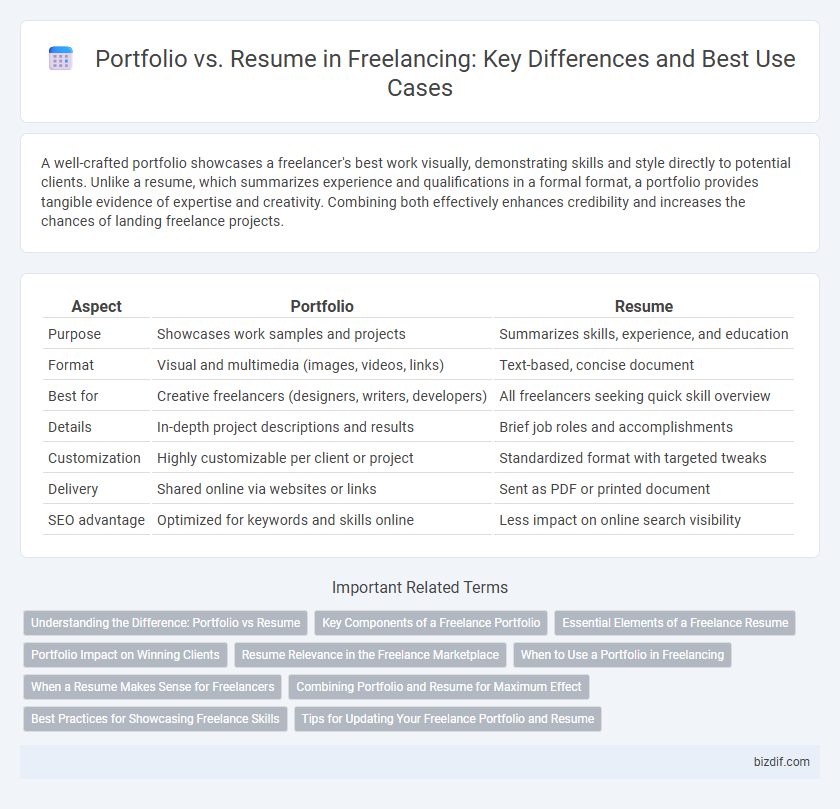A well-crafted portfolio showcases a freelancer's best work visually, demonstrating skills and style directly to potential clients. Unlike a resume, which summarizes experience and qualifications in a formal format, a portfolio provides tangible evidence of expertise and creativity. Combining both effectively enhances credibility and increases the chances of landing freelance projects.
Table of Comparison
| Aspect | Portfolio | Resume |
|---|---|---|
| Purpose | Showcases work samples and projects | Summarizes skills, experience, and education |
| Format | Visual and multimedia (images, videos, links) | Text-based, concise document |
| Best for | Creative freelancers (designers, writers, developers) | All freelancers seeking quick skill overview |
| Details | In-depth project descriptions and results | Brief job roles and accomplishments |
| Customization | Highly customizable per client or project | Standardized format with targeted tweaks |
| Delivery | Shared online via websites or links | Sent as PDF or printed document |
| SEO advantage | Optimized for keywords and skills online | Less impact on online search visibility |
Understanding the Difference: Portfolio vs Resume
A resume provides a concise summary of skills, work experience, and education tailored to a specific job application, highlighting qualifications in a structured format. A portfolio showcases a curated collection of work samples, projects, and case studies, demonstrating practical skills and accomplishments in action. Understanding the difference ensures freelancers effectively present both credentials and capabilities to potential clients.
Key Components of a Freelance Portfolio
A freelance portfolio showcases real projects, highlighting skills, creativity, and problem-solving abilities through visual samples, case studies, and client testimonials. It includes detailed descriptions of completed work, tools used, and measurable outcomes, providing proof of expertise beyond a traditional resume. A portfolio emphasizes versatility and specialization, making it essential for attracting clients and securing freelance contracts.
Essential Elements of a Freelance Resume
A freelance resume should highlight key elements such as relevant skills, project experience, and client feedback to demonstrate expertise and reliability. Including quantifiable achievements and a clear summary of services offers potential clients a concise understanding of capabilities. Unlike portfolios, resumes prioritize brevity and targeted information to quickly convey professional qualifications.
Portfolio Impact on Winning Clients
A well-crafted portfolio showcases a freelancer's skills, creativity, and successful projects, providing tangible proof of expertise that a resume alone cannot convey. Clients are more likely to trust and hire freelancers who present detailed case studies, diverse work samples, and measurable outcomes in their portfolios. This visual and evidence-based approach significantly increases the chances of winning clients and securing high-value gigs in competitive freelancing markets.
Resume Relevance in the Freelance Marketplace
A resume highlights a freelancer's skills, experience, and professional achievements in a concise format tailored for potential clients and platforms in the freelance marketplace. Unlike portfolios, resumes emphasize quantifiable accomplishments and specific competencies relevant to project requirements, increasing a freelancer's credibility and marketability. Freelancers with well-structured resumes often experience enhanced visibility and higher chances of securing contracts in competitive industries.
When to Use a Portfolio in Freelancing
A portfolio is essential in freelancing when showcasing creative work, such as graphic design, writing, or web development, where visual samples or project outcomes demonstrate skills effectively. Use a portfolio to provide potential clients with detailed evidence of your expertise, style, and the quality of previous projects, boosting credibility and trust. A portfolio is particularly valuable during client pitches, proposals, and interviews for project-based or contract work that requires tangible proof of capability.
When a Resume Makes Sense for Freelancers
Freelancers benefit from a resume when applying for project-based roles with companies that require formal documentation of work history and skills. Resumes make sense in industries such as marketing, consulting, or IT, where clear presentation of qualifications, certifications, and previous employment helps build trust with potential clients. Maintaining a concise, tailored resume alongside a portfolio highlights both professional experience and project successes.
Combining Portfolio and Resume for Maximum Effect
Combining a portfolio with a resume creates a powerful tool that showcases both skills and concrete work examples, enhancing credibility for freelancers. Portfolios provide visual proof of expertise, while resumes summarize qualifications, experience, and achievements, giving a comprehensive view to potential clients or employers. Integrating both formats maximizes impact by demonstrating professional capabilities alongside detailed evidence of completed projects, increasing the chances of securing freelance opportunities.
Best Practices for Showcasing Freelance Skills
A freelance portfolio should highlight diverse projects with detailed descriptions, client feedback, and visual evidence of skills to demonstrate real-world expertise. Resumes for freelancers must be concise, tailored to specific job requirements, and emphasize quantifiable achievements and relevant skills. Combining a well-structured portfolio with a targeted resume increases credibility and attracts potential clients in competitive freelancing markets.
Tips for Updating Your Freelance Portfolio and Resume
Regularly updating your freelance portfolio with recent projects showcasing diverse skills and measurable results enhances client trust and marketability. Tailor your resume by highlighting relevant freelance experiences, emphasizing accomplishments with quantifiable metrics and keywords aligned with targeted industries. Integrate client testimonials and certifications in both portfolio and resume to strengthen credibility and professional appeal.
Portfolio vs Resume Infographic

 bizdif.com
bizdif.com